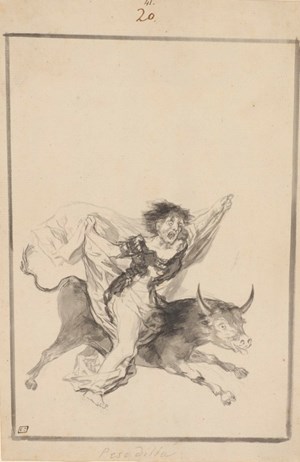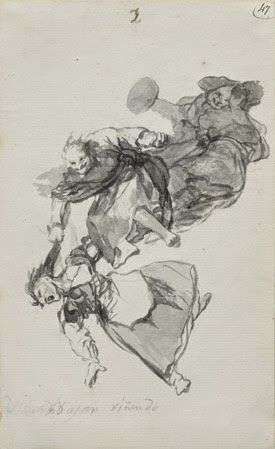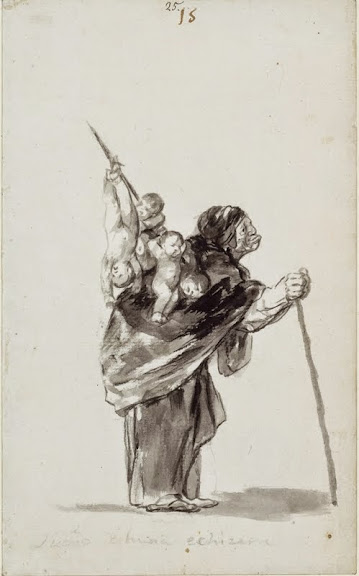
The Courtauld Gallery has been housing a ground-breaking exhibition on the painter’s drawings since last February. It reconstructs, for the first time, a whole Goya album in its original sequence. The album D is thought to have been made between 1819 and 1823. It is the most mysterious and less known of all the albums and it has the least clear objective. Lunatics, witches and magic are mixed together with popular topics leaving us with the sense of a disturbing reality.
An old woman leans on her stick under the weight of a bundle of babies, two women fight against each other with all their strength, a witch-like character screams in terror and clutches a bed sheet as she rides on a flying bull. All these characters and scenes contribute to build a sinister atmosphere in the rooms of the exhibition Goya: the Witches and Old Women Album.
The Courtauld Gallery has been housing a ground-breaking exhibition on the painter’s drawings since last February. It reconstructs, for the first time, a whole Goya album in its original sequence.
Alongside his public role as court painter to the Spanish crown, Goya began to create albums of drawings when he was in his fifties, after a disease that let him deaf. He produced eight albums, (known by the letters A to H), each offering rich insights into the private world of his boundless imagination.
After he died, his son Javier and grandson Mariano sold most of his album, splitting more than 100 drawings among the State and private collections. Since then, all the drawings have been part of different museums and private collections around the world.
 |
| Francisco de Goya (1746- 1828) Bajan riñendo, (They descend quarrelling) 'Witches and Old Women' Album (D), page 1 c. 1819-23, Brush, black and grey ink, 235 x 143 mm Private Collection |
The Courtauld has gone to great effort to reunite all twenty-two surviving drawings (there is only one lost) from the Album D also known as the Witches and Old Women Album for this exhibition curated by Stephanie Buck and Juliet Wilson-Bareau.
The album D is thought to have been made between 1819 and 1823. It is the most mysterious and less known of all the albums and it has the least clear objective. Lunatics, witches and magic are mixed together with popular topics leaving us with the sense of a disturbing reality.
It is not clear if what we see is what the painter observed in his everyday life, part of his fantasies or reproductions of dreams. It is known that he drew cartoons before his fifties and he has always been an observer of humans. In these drawings Goya seems to be suggesting, more than representing the reality, allowing space for the viewer to complete the scene. In any case, the mystery of what is real and what is fantasy endures and provides part of the charm of this show.
The exhibition is certainly a survey of a dark time, an obscure Spain, where horrible habits and traditions were just part of daily life. But yet, Goya succeed in adding a scent of irony and humour in his albums. In these drawings and in previous works he seems to use cartoons as a way to both represent and criticise what was around him.
What is most attractive about this show is its exquisiteness. Every drawing is a little treasure now available to the fortunate public. This idea is confirmed when one hears about the story behind each drawing told by Juliet Wilson-Bareau, the exhibition co-curator and one of the foremost authorities on Goya.
 |
| Francisco Goya (1746- 1828) Sueno de buena echizera (Dream of a good witch) 'Witches and Old Women' Album (D), page 15, c. 1819-23 Brush, black and grey ink, 234 x 144 mm Berlin, Staatliche Museen zu Berlin Preussischer, Kulturbesitz, Kupferstichkabinett, kdz 4396 |
She talks about the drawings with the passion and preciseness of someone that has dedicated most of her time to one person and knows him very well.
This project is to her a milestone in the study of Goya oeuvre. On the one hand, its value remains in the task of reuniting all the pages from 16 museums and several private collections. On the other hand, there was the task of analysing the drawings and trying to work out the original sequence. The numbers were erased, and Madrazo, one of the first album owners, added new numbers. So, to discover the original order the curatorial team have been analysing the ink marks in offset, observing the very faint mark of old numbers, studying the paper composition and paying attention to the different conservation state.
The drawings in the show are quite revealing, according to Wilson-Bareau, because one can really be inside Goya’s mind and discover his creative process on paper. Some marks and ink marks demonstrate that the painter had a sketch planned in mind but then let himself flow while painting, changing the positions of an arm, the movement of the body or other elements.
In any case, they are not preparatory drawings. The type of paper, the size, the outline and the ink demonstrate that he had the intention to do something more. Some early proofs of lithography have been found afterwards, with other sketches of Goya, but not done by him, which makes the experts think that he was planning on transferring the drawings to lithography.
The exhibition Goya: The Witches and Old Women album, in The Courtauld Gallery of London until 25 May, is able to provide an insight to the painter’s mind and the time he lived in. A great number of parallel activities have been programmed, with much creativity to immerse the public in Goya’s world: from school activities to late night events such as “Wonderfully wicked women and witches”, (on 7 May), which includes Live Spanish Guitar music, pop up mime and cabaret or a gin tasting called “Mother’s Ruin”.
Image above is: Francisco Goya (1746-1828)
Pesadilla (Nightmare)
'Black Border' Album (E), page 20, c. 1816-20
Brush, black ink with wash and scraping, 364 x 181 mm
New York, The Morgan Library & Museum, 1959.13

ArtDependence Magazine is an international magazine covering all spheres of contemporary art, as well as modern and classical art.
ArtDependence features the latest art news, highlighting interviews with today’s most influential artists, galleries, curators, collectors, fair directors and individuals at the axis of the arts.
The magazine also covers series of articles and reviews on critical art events, new publications and other foremost happenings in the art world.
If you would like to submit events or editorial content to ArtDependence Magazine, please feel free to reach the magazine via the contact page.